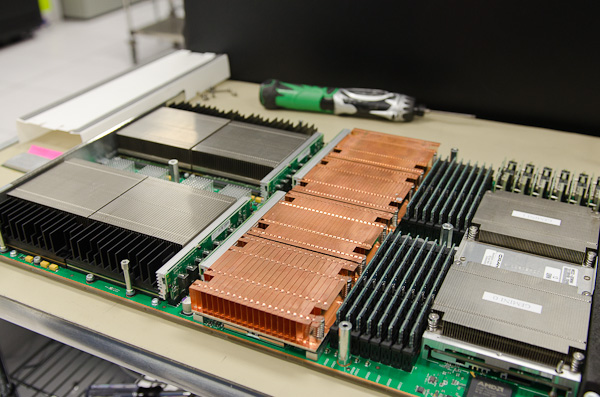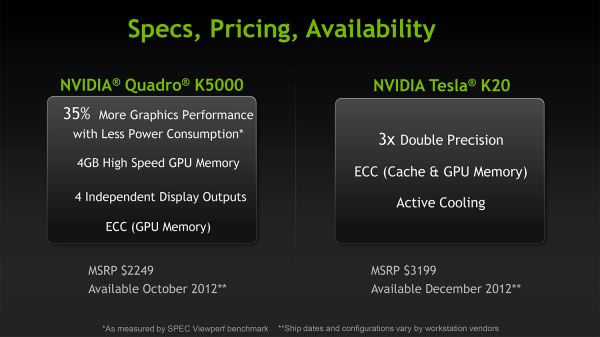NVIDIA Launches Tesla K20 & K20X: GK110 Arrives At Last
by Ryan Smith on November 12, 2012 9:00 AM ESTNVIDIA Launches Tesla K20, Cont
To put the Tesla K20's performance in perspective, this is going to be a very significant increase in the level of compute performance NVIDIA can offer with the Tesla lineup. The Fermi based M2090 offered 655 GFLOPS of performance with FP64 workloads, while the K20X will straight-up double that with 1.31 TFLOPS. Meanwhile in the 225W envelope the 1.17 TFLOPS K20 will be replacing the 515 GFLOPS M2075, more than doubling NVIDIA’s FP64 performance there. As for FP32 workloads the gains are even greater due to the fact that NVIDIA’s FP64 rate has fallen from ½ on GF100/GF110 Fermi to 1/3 on GK110 Kepler; the 1.33 TFLOPS M2090 for example is being replaced by the 3.95 TFLOPS K20X.
Speaking of FP32 performance, when asked about the K10 NVIDIA told us that K20 would not be replacing K10, rather the two will exist side-by-side. K10 actually has better FP32 performance at 4.5 TFLOPs (albeit split across two GPUs), but as it’s based on the GK104 GPU it lacks some Tesla features like on-die (SRAM) ECC protection and HyperQ/Dynamic Parallelism. For the user base that could already be sufficiently served by the K10 it will continue to exist for those users, while for the FP64 users and users who needed ECC and other Tesla features K20 will now step up to the plate as NVIDIA’s other FP32 compute powerhouse.
The Tesla K20 family will be going up against a number of competitors, both traditional and new. On a macro level the K20 family and supercomputers based on it like Titan will go up against more traditional supercomputers like those based on IBM’s BlueGene/Q hardware, which Titan is just now dethroning in the Top500 list.

A Titan compute board: 4 AMD Opteron (16-core CPUs) + 4 NVIDIA Tesla K20 GPUs
Meanwhile on a micro/individual level the K20 family will be going up against products like AMD’s FirePro S9000 and FirePro S10000, along with Intel’s Xeon Phi, their first product based on their GPU-like MIC architecture. Both the Xeon Phi and FirePro S series can exceed 1 TFLOPS FP64 performance, making them potentially strong competition for the K20. Ultimately these products aren’t going to be separated by their theoretical performance but rather their real world performance, so while NVIDIA has a significant 30%+ lead in theoretical performance over their most similar competition (FirePro S9000 and Xeon Phi) it's too early to tell whether the real world performance difference will be quite that large, or conversely whether it will be even larger. Tool chains will also play a huge part here, with K20 relying predominantly on CUDA, the FirePro S on OpenCL, and the Xeon Phi on x86 coupled with Phi-specific tools.
Finally, let’s talk about pricing and availability. NVIDIA’s previous projection for K20 family availability was December, but they have now moved ahead by a couple of weeks. K20 products are already shipping to NVIDIA’s server partners, with those partners and NVIDIA both getting ready to ship to buyers soon after that. NVIDIA’s general guidance is November-December, so some customers should have K20 cards in their hands before the end of the month.
Meanwhile pricing will be in the $3000 to $5000 range, owing mostly to the fact that NVIDIA’s list prices rarely line up with the retail price of their cards, or what their server partners charge customers for specific cards. Back at the Quadro K5000 launch NVIDIA announced a MSRP of $3199 for the K20, and we’d expect the shipping K20 to trend close to that. Meanwhile we expect the K20X to trend closer to $4000-$5000, again depending on various markup factors.

K20 Pricing As Announced During Quadro K5000 Launch
As for the total number of cards they’re looking at shipping and the breakdown of K20/K20X, NVIDIA’s professional solutions group is as mum as usual, but whatever it is we’re being told it won’t initially be enough. NVIDIA is already taking pre-orders through their server partners, with a very large number of pre-orders outstripping the supply of cards and creating a backlog.
Interestingly NVIDIA tells us that their yields are terrific – a statement backed up in their latest financial statement – so the problem NVIDIA is facing appears to be demand and allocation rather than manufacturing. This isn’t necessarily a good problem to have as either situation involves NVIDIA selling fewer Teslas than they’d like, but it’s the better of the two scenarios. Similarly, for the last month NVIDIA has been offering time on a K20 cluster to customers, only for it to end up being oversubscribed due to the high demand from customers. So NVIDIA has no shortage of customers at the moment.
Ultimately the Tesla K20 launch appears to be shaping up very well for NVIDIA. Fermi was NVIDIA’s first “modern” compute architecture, and while it didn’t drive the kind of exponential growth that NVIDIA had once predicted it was very well received regardless. Though there’s no guarantee that Tesla K20 will finally hit that billion dollar mark, the K20 enthusiasm coming out of NVIDIA is significant, legitimate, and infectious. Powering the #1 computer in the Top500 list is a critical milestone for the company’s Tesla business and is just about the most positive press the company could ever hope for. With Titan behind them, Tesla K20 may be just what the company needs to finally vault themselves into a position as a premiere supplier of HPC processors.











73 Comments
View All Comments
CeriseCogburn - Thursday, November 29, 2012 - link
LOL - wrong again amd fanboyBullwinkle J Moose - Tuesday, November 13, 2012 - link
K20X384 bit bus
6 GB VRAM
7.1 Billion Transistors
3.95 TFLOP Single Precision
1.31 TFLOP Double Precision
$3200
Sounds impressive but can it play Crisis?
Bullwinkle J Moose - Wednesday, November 14, 2012 - link
CRYSISCeriseCogburn - Thursday, November 29, 2012 - link
You both meant Crysis Warhead, frost bench, an amd advantage favorite for a single amd win of late, not Crysis 2.LOL
the bias is screaming out
eddman - Monday, November 12, 2012 - link
"I am a Nvidia fanboi."You do know that fanboy means "A stupid and highly biased fan", right?
The term you'd want to use is simply "Fan".
Denithor - Monday, November 12, 2012 - link
I think that was his point exactly - he's a RABID nVidia fan but still finds it off balance the differential treatment for the two companies.CeriseCogburn - Thursday, November 29, 2012 - link
The truth is probably he's a rabid amd fanboy in disguiseSabresiberian - Tuesday, November 13, 2012 - link
The "stupid" part is YOUR interpretation, it's not what it means to most people.Biased, yes, stupid, no.
CeriseCogburn - Thursday, November 29, 2012 - link
Biased because, while being so stupid, so obsessed, so doused in tampon and motrin lacking estrogenic emoting for the team, that facts simply do not matter, and spinning Barney and and Nancy and Harry would be proud of, becomes all that spews forth.Stupid is definitely part of it, coupled with a huge liar factor.
It may be the washing of the brain coupled with the excessive female hormone problems are the base cause, but in every case except flat out devious lying troll for amd, paid or unpaid, stupidity is a very large component.
dragonsqrrl - Monday, November 12, 2012 - link
'An article about an AMD product got only 1 page of coverage while an article about an Nvidia product got 3, BIAS, FAVORITISM, FANBOI'Dude really, grow up. You're just about the last person who should be throwing around accusations of bias and fanboism. Do you really have nothing better to do than to troll and whine on Tom's and Anand, about how the whole world is conspiring against your benevolent AMD?